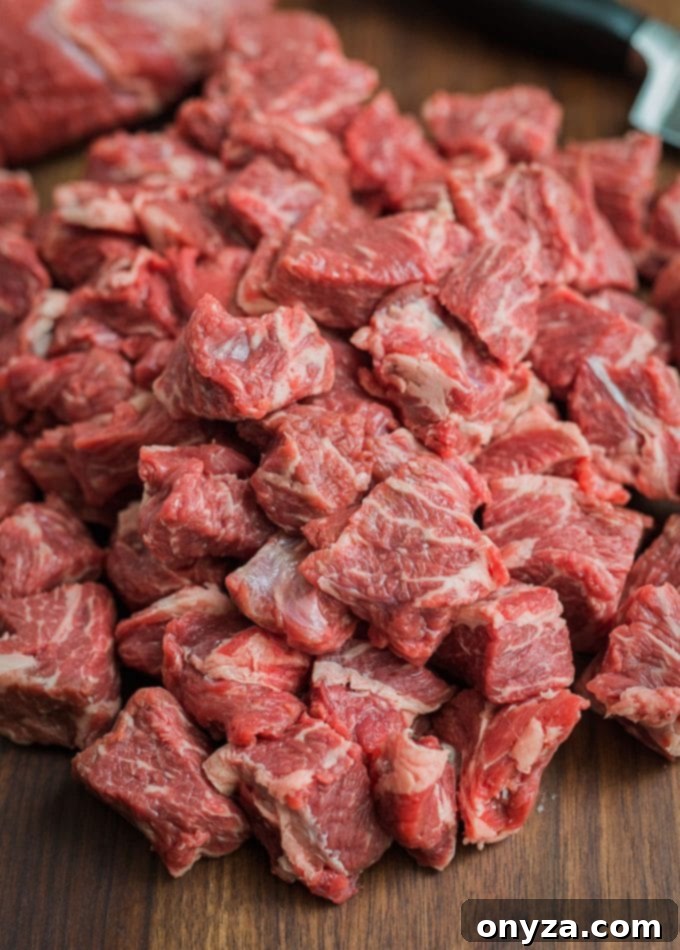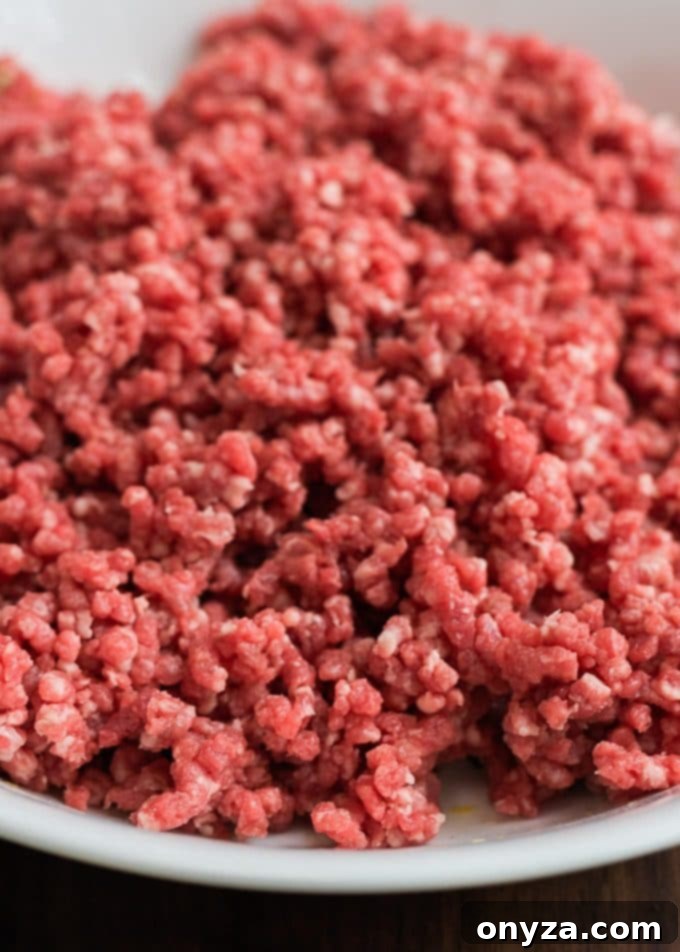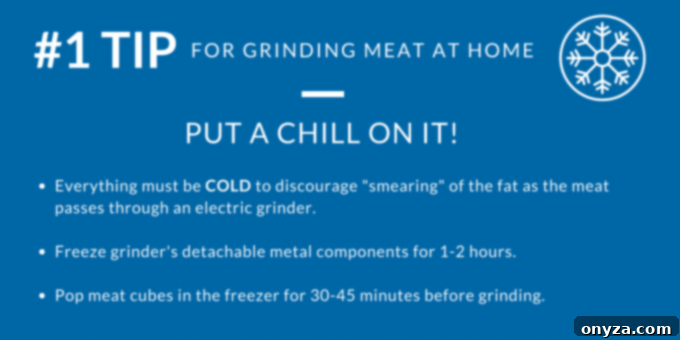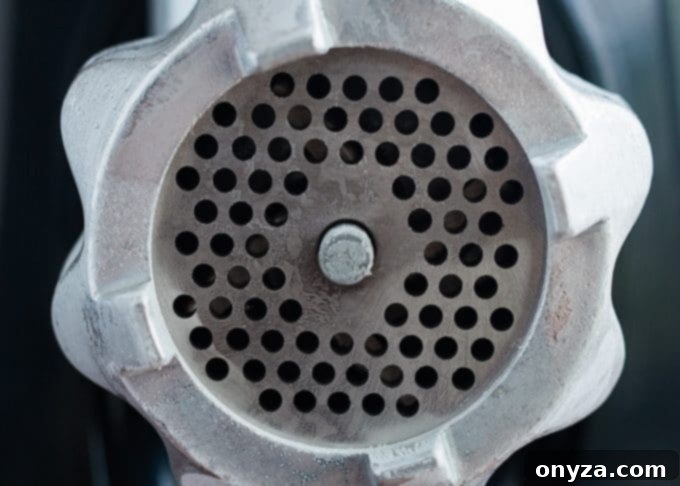Discover the secret to elevating your culinary creations, from succulent burgers and flavorful meatballs to hearty meatloaf and artisanal homemade sausage: grinding meat at home. It’s an effortless process that yields unparalleled taste and texture!
Unlock Superior Flavor and Texture: The Art of Grinding Meat at Home
Have you ever taken a bite of a burger or a meatball and felt a pang of disappointment? Perhaps the texture was unpleasantly dense, riddled with chewy gristle, or simply lacked that deep, satisfyingly meaty flavor you crave. It’s a common experience for many home cooks who rely on pre-ground meats from the supermarket. The truth is, the quality, freshness, and overall deliciousness of ground meat can vary dramatically, often leaving much to be desired.
Whether your recipe calls for beef, pork, poultry, veal, or even a surprising choice like seafood (yes, fish can be ground too!), there’s an incredibly simple yet transformative solution to bland, uninspired ground meat: grinding it yourself at home. The difference between freshly ground meat prepared in your own kitchen and its store-bought counterpart is often described as night and day. Home grinding offers an incomparable boost in quality, flavor intensity, and a superior, custom-tailored texture that can elevate everyday dishes into extraordinary culinary experiences.
Grinding Meat at Home: Easier and Faster Than You Think!
Many home cooks mistakenly believe that grinding meat at home is a time-consuming, difficult, or messy endeavor. My own initial assumption was precisely that. However, after the very first attempt, I was not only proven wrong but instantly hooked! The process is surprisingly quick and straightforward, and the rewards far outweigh the minimal effort involved. Fortunately, a variety of accessible methods are available to allow any home cook to enjoy the benefits of fresh, homemade ground meat.
Popular Methods for Home Meat Grinding:
- Stand Mixer Attachments: For those who own a versatile kitchen appliance like a KitchenAid® stand mixer, a dedicated grinder attachment is a fantastic investment. These attachments easily affix to the front power hub and utilize the mixer’s motor, making the grinding process efficient and hands-free. They are perfect for regular home use and smaller to medium-sized batches, delivering consistent results with minimal fuss.
- Standalone Electric Grinders: If you find yourself frequently grinding larger quantities of meat for things like batch cooking, sausage making, or feeding a crowd, a standalone electric meat grinder is an excellent choice. These dedicated units offer more power and often come with a wider array of plates and accessories, making them incredibly versatile for various grinding needs and textures. Their robust design handles tougher cuts and larger volumes with ease.
- Hand-Crank Grinders: For a more traditional approach or for those who prefer a non-electric option, manual hand-crank models are a reliable alternative. These grinders typically clamp securely to a countertop or table and require manual operation. While they demand a bit more physical effort, they are often more affordable, durable, and offer the satisfaction of a hands-on culinary experience, perfect for smaller batches or rustic preparations.
- Food Processor: In a pinch, your trusty food processor can step in, though it’s generally not my preferred method for achieving a true “ground” texture. Instead of a uniform grind, the meat tends to be more finely chopped. However, for certain applications or when no other option is available, it gets the job done. For tips on this technique, check out this helpful tutorial from Kitchn on processing meat in a food processor.
- Chopping by Hand (Knife Skills): For the culinary purist or those with exceptional knife skills, finely chopping meat by hand offers unparalleled control over texture. This method, often called “mincing,” results in a unique, coarser texture that some chefs prefer for specific dishes like steak tartare or certain types of burgers. It’s a labor of love but can yield a truly distinct product.
For a comprehensive, side-by-side comparison illustrating the nuances and effectiveness of these various home grinding options, I highly recommend exploring “The Burger Lab: What’s the Best Way To Grind Beef” by J. Kenji Lopez-Alt over at Serious Eats. You can find this invaluable resource here.



Unbeatable Advantages: Why Grinding Meat at Home Transforms Your Cooking
The decision to grind your own meat at home brings with it a host of compelling benefits that significantly impact the quality, safety, and flavor of your dishes. Beyond just improving taste, it empowers you with an unprecedented level of control over what goes into your food. Here’s a closer look at the key advantages:
- Complete Control Over Ingredients: Perhaps the most significant advantage is knowing exactly what constitutes your finished ground product. You select the specific cuts of meat, ensuring their quality, freshness, and source. This transparency is a stark contrast to store-bought ground meats, which can sometimes contain less desirable trimmings or a mix of unclear origins. You can confidently avoid unwanted additives, preservatives, or fillers – remember the infamous “pink slime” controversy? With home grinding, those concerns become a thing of the past.
- Customizable Flavor Profiles: Home grinding allows you to create bespoke blends of meat, unlocking complex and unique flavor profiles. For beef, you might combine richly marbled chuck with short rib for added richness, or brisket for a deeper, beefier taste in your burgers. For pork, a mix of shoulder and belly can create the perfect balance for sausage. This ability to mix and match different cuts, even across different types of meat, opens up a world of culinary experimentation and ensures your ground meat perfectly suits your recipe.
- Optimal Fat Content Management: You are in charge of the fat-to-lean ratio. Whether you prefer a leaner grind for health reasons or a higher fat content for juicier burgers and more flavorful sausages, you can trim as much or as little fat as you desire from the primal cut. This precision control allows you to tailor the fat content to both your dietary preferences and the specific needs of the dish you’re preparing.
- Elimination of Gristle and Undesirable Bits: One of the most common complaints about store-bought ground meat is the presence of gristle, sinew, or tough connective tissue. When you grind at home, you have the opportunity to meticulously trim away all gristle, silver skin, and any other undesirable tough bits while cutting the meat into cubes before it ever enters the grinder. This meticulous preparation guarantees a consistently smooth and pleasant texture in your final product.
- Achieve Your Desired Coarseness: Most electric meat grinders come equipped with an assortment of cutting plates, typically ranging from coarse to fine. This simple change allows you to dictate the texture of your ground meat, ensuring it’s perfectly suited for your recipe. A coarse grind is excellent for hearty chili or robust burgers, offering a satisfying chew. A medium grind is versatile for meatballs and meatloaf, while a fine grind is ideal for delicate pâtés, smooth sausages, or certain types of fillings.
Curious about which cutting plate yields the best burger? Explore “How Coarsely Should I Grind my Burger?” a definitive guide from J. Kenji Lopez-Alt, available here.
Mastering the Grind: Essential Tips for Success at Home
Achieving consistently excellent results when grinding meat at home is simple, especially when using an electric standalone grinder or a stand mixer attachment (my personal favorite methods). Follow these crucial tips to ensure your homemade ground meat is perfect every time:
Pre-Grinding Preparation is Key:
- Choose Your Cut of Meat Wisely: The foundation of great ground meat starts with the right cut. For most applications, especially juicy burgers, flavorful meatballs, or moist meatloaf, you’ll want to select cuts with a good amount of fat marbling. Economical cuts are often ideal here. For beef, well-marbled chuck roast (as pictured above) is a perennial favorite for its flavor and juiciness. For pork, shoulder or “butt” grinds beautifully, and depending on the recipe, can be blended with a leaner cut like loin for balance. When grinding chicken, use thighs for more flavor and moisture than breasts alone.
- Trim and Cut Meticulously: Before grinding, prepare your meat by removing any unwanted skin, tough membranes, large pockets of fat (unless you specifically want to include them for flavor), and all gristle. Cut the meat into uniform 1-2 inch cubes. The exact size will depend on the diameter of your grinder’s feeding tube, but consistency helps ensure even grinding and prevents the machine from getting clogged.
The Importance of Chill:
This step cannot be overemphasized. To prevent fat from “smearing” (a process where fat melts and coats the lean meat, resulting in a greasy, pasty texture rather than distinct strands of ground meat), everything involved in the grinding process must be kept exceptionally cold.
- Chill Your Equipment: Prior to grinding, place all detachable metal components of your grinder – including the grinder head, cutting plates, and auger (the spiral feed screw) – into your freezer for 1-2 hours. This ensures they are thoroughly chilled and will help maintain the meat’s temperature as it passes through.
- Chill Your Meat: The cubed meat itself should be extremely cold and firm, but not frozen solid. Move your pre-cut meat from the refrigerator to the freezer for approximately 30-45 minutes before you begin grinding. It should feel stiff to the touch but still be pliable enough for the grinder to process easily.
During and After Grinding:
- Work Quickly and Efficiently: To maintain the ideal cold temperature of both your equipment and the meat, it’s crucial to work without interruption. Grinding several pounds of meat usually takes only a few minutes. Avoid distractions like phone calls or stepping away from the task. If you absolutely must take a break during a grinding session, re-chill the meat and thoroughly wash and re-freeze the grinder attachments before resuming to prevent any temperature compromise.
- Prevent Cross-Contamination: Food safety is paramount. If you are grinding different types of meat in batches (e.g., pork, then beef, then poultry), always thoroughly clean and sanitize all grinder components between each variety. This prevents the transfer of bacteria and ensures the purity of each meat type.
- Freshness is Best: Homemade ground meat is incredibly fresh, which means it’s also highly perishable. For optimal safety and flavor, plan to cook or freeze your freshly ground meats within 24 hours of grinding. Portioning into airtight bags or containers before freezing is a great way to preserve quality and convenience.

*Always ensure you follow the specific operation and safety instructions provided by your equipment manufacturer for the best results and safe use.
Inspiring Recipes from Striped Spatula Featuring Freshly Ground Meat:
Now that you’re equipped with the knowledge and confidence to grind your own meat, it’s time to put those skills to delicious use! Explore these fantastic recipes from Striped Spatula, all designed to showcase the superior flavor and texture of freshly ground meat:
- Smoky Grilled Meatball Subs
- Chef Evan Blomgren’s Buffalo Chicken Meatballs
- Chicken and Vegetable Potstickers
- Mojo Beef Burgers with Tequila-Lime Aioli
